- It’s what we do – adventure motorbike magazine
- BMW GS Safari Enduro = adventure motorbikes, news, reviews, publication
- BMW F850GS Rallye X
- Strap Yourself In
- The Dempster
- TomTom Rider 450
- Read Between The Lines
- Locked Gates – motorbike magazine, australian motorcycle publication
- Ural Adventure Ride 2018
- Sri Lanka – adventure motorbike tour, motorcycle magazine
- The Best Job In The World = australian motorbike magazine
- Wet Arses
- Yamaha Tracer 900
- Congregation 2018
- We Didn’t Have PLBs In Those Days
- Sahara To Sunraysia = australian motorbike riding tours news event magazine
- Managing Risk with Miles Davis
- Thinking Big? Start Small with Andy Strapz
- A Precautionary Tale from Karen Ramsay
- Checkout
- Fit out – australian adventure motorbike riding
40 years of extreme adventure riding
If there’s an historian of cross-country rally riding in Australia, it’s Peter Whitaker. He’s written extensively about desert rally racing in The Land Downunder. This issue he has a look at the evolution of Australia’s newest rally, The Sunraysia Safari.
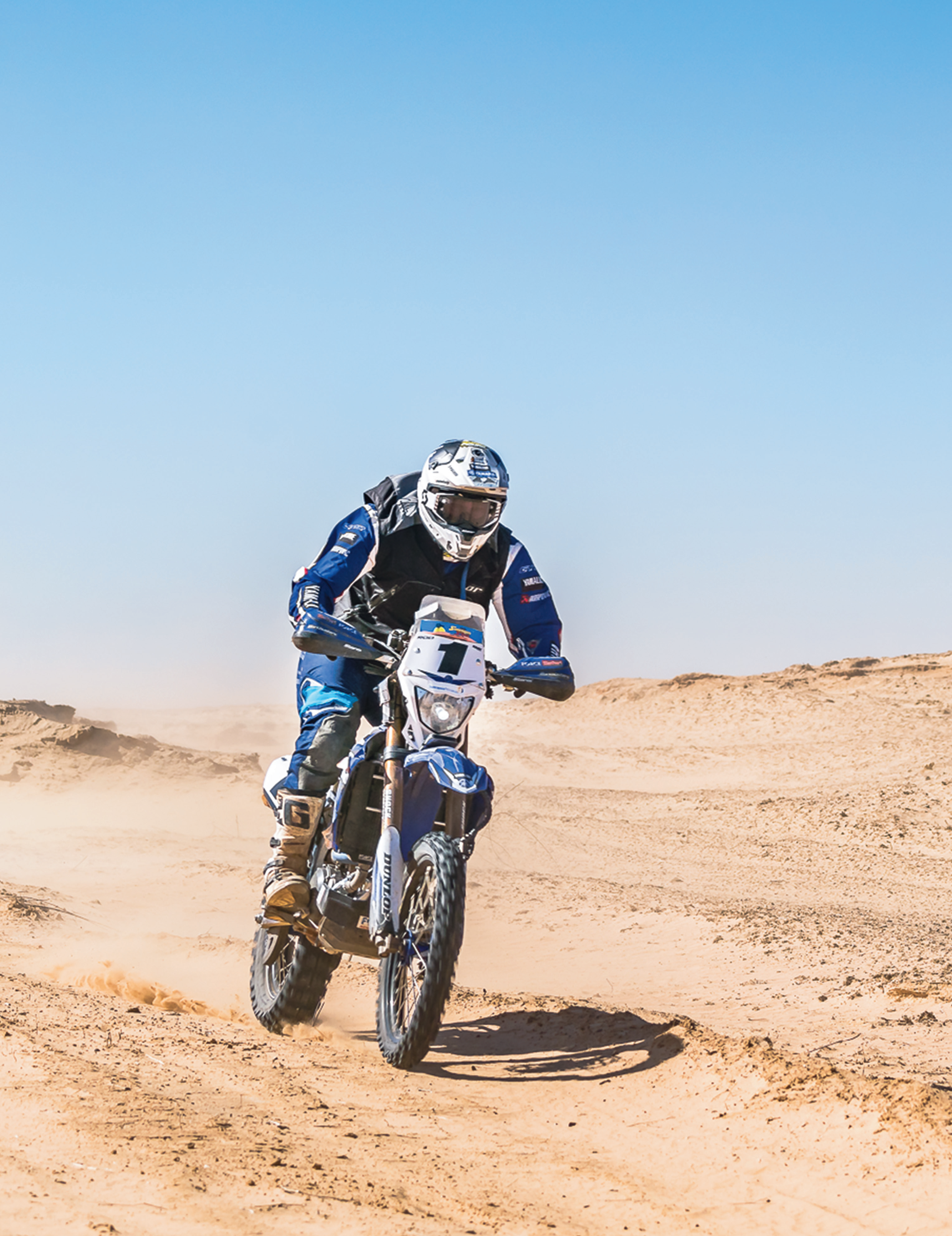
The original ‘rally raid’ was an adventure like no other before. An eclectic cohort of champagne-fuelled Froggies framped across the Sahara Desert in a race against time to celebrate the new year on the French Riviera. Certainly the motorcyclists taunted the crews in the dilapidated Peugeots who, in turn, scoffed at those in the rudimentary VW-powered buggies. But the real challenge was the terrain, not each other. And by all accounts there was a great sense of camaraderie as the participants overcame the trials they faced.
 2017 champion, and two-time Australian Safari winner, Rod Faggotter took second on a Yamaha YZ450F cunningly stickered as a WR450F.
2017 champion, and two-time Australian Safari winner, Rod Faggotter took second on a Yamaha YZ450F cunningly stickered as a WR450F.
Wynners
The inaugural Wynn’s Sydney To Darwin Safari had similar attributes; the challenge of surviving a 7000km odyssey across Australia’s most remote regions.
The first event proved such a trial that, had it not been for a change of heart by the organisers, three out of every four participants would have been eliminated on the very first day. As it eventuated, less than a quarter of the riders made it to Darwin.
No matter, the adventure continued each year for the best part of two decades, although on each and every occasion less than a handful of riders were actually competing against one another.
The majority were there simply for the adventure – to overcome the difficulties thrown at them in Australia’s unforgiving outback. And, for some, there came the satisfaction of receiving a Safari-finishers’ medallion.

Tough times
Times change, and when the Safari was rebirthed in Western Australia it was a series of cross-country sprints linked by regular service points and over-night rebuilds. For sure, it was serious cross-country racing, but the arduous 10-hour marathons out in the mulga with only a spare tube and a bumbag for company were long gone. To cater for those riders lacking the skills or the deep pockets to field a dedicated competition bike, the organisers introduced a tag-along Safari Adventure Ride which was almost immediately oversubscribed. This clearly demonstrated scores of riders were prepared to cross the continent to enjoy the Safari experience without the pressure of competition. Then, after eight years of sponsorship struggles, the escalating cost of insurance and the logistics of running an event with a million-square-mile footprint, the Westralian Safari folded its tent. On the east coast the Condo 750, itself spawned by the Australian Safari,was the sole surviving navigation event.

A new era
Bless Troy Bennett who, against all odds, revived cross-country rallying in 2017 with a four-day event based in Mildura.
Troy wasn’t killed in a stampede of entrants, but the Sunraysia Safari providedthe impetus to up the ante for 2018 when, with considerable enthusiasm, Wentworth Shire Council provided the essential infrastructure with full access to the showgrounds for use as event headquarters. Perfect.
Not so the weather. Despite high winds, deep sand, suicidal wildlife and, on the fifth and final day, a heavy shower of rain that didn’t break the drought – but did turn the mallee desert clay pans into skating rinks – Honda CRF450-mounted Jake Smith won the 2500km event ahead of 2017 champion and two-time Australian Safari winner Rod Faggotter on a Yamaha YZ450F (cunningly stickered as a WR450F).
The KTM 500EXC of Finke Desert Race veteran Luke Hayes filled the podium after winning the final day, while Toby Hederics and Beau Hederics, sons of 10-time Australian Safari Champion John Hederics, completed the top five. Both chips off the old block, the Hederics lads demonstrated they had the pace, taking the quinella on the first day on a pair of immaculately prepared KTM 500EXCs.
Faggotter won the second day and Smith the third; moving into the overall lead and hoping to get clear air at the front of the field on day four.
But, having won the lead, Smith – a two-time Australian Safari winner him-self – became the first to experience the 70kph headwinds which quickly raised a dust storm and cut visibility to less than 10 metres.
“It’s the first time I’ve ever led a Safari at less than 40kph,” said Smith, “and I just had to ride blind, trusting the route chart to avoid the barbed-wire fences.”
The day brought both good news and bad for Smith. At the conclusion he had marginally increased his overall lead, but on the final liaison stage back to the bivouac his engine was making very ominous sounds. With a tow from his main adversary, Rod Faggotter, he managed to coax it home for an engine swap which allowed him to protect his overall lead throughout the final day.
Any chance Faggotter had to bridge the gap was undone with coils of fencewire around his rear wheel, “Which is why sidecutters are always on top in the bumbag,” said Rod.
He didn’t do so well a few years later on a Moto Guzzi or the Cagiva Elefant, though the term ‘adventure bike’ hadn’t then entered the lexicon. But it had by the time Craig Hartley rode a KTM 950 to a top 10 finish in 2003.
Troy Bennett’s open invitation to adventure riders was to promote the recreational aspects of cross-country rallying and, while pre-event publicity was low key, it attracted Paul Bannister down from sunny Queensland on his KTM 1190R, Gary Monaghan from Victoria on his Kato 690 Adventure and Conrad Fairhead all the way from WA on a 2005 Kato 950. Also entered in H3 (over 450cc) class was the Paul Rooney-built BMW airhead; a 1982 R65-powered special in a bespoke frame with, among other ‘production’ parts, a DRZ400 front end.
To my mind Ant Diener’s SWM RS and Travis Gow’s 2004 Honda XR650 were also there for the adventure rather than the race.
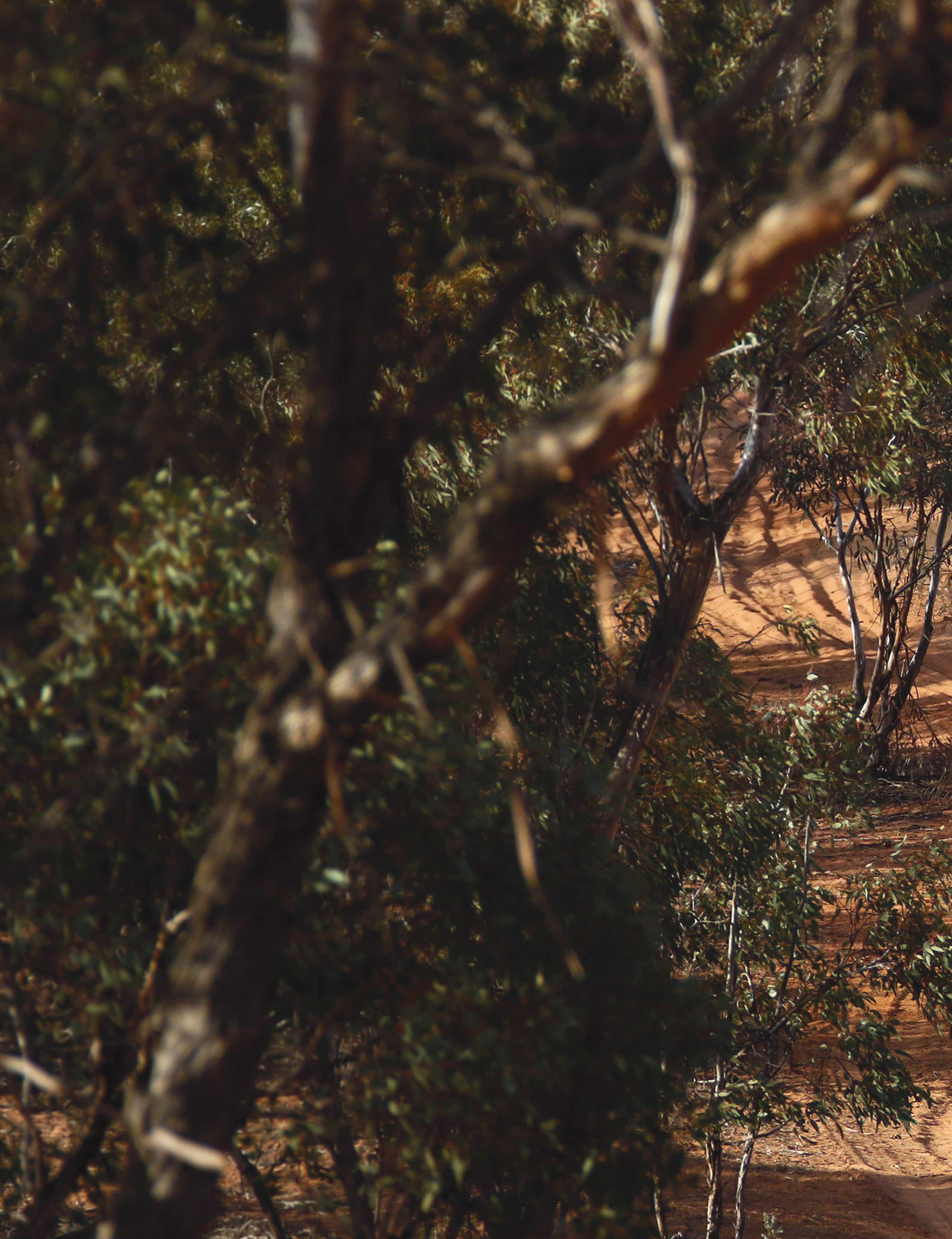
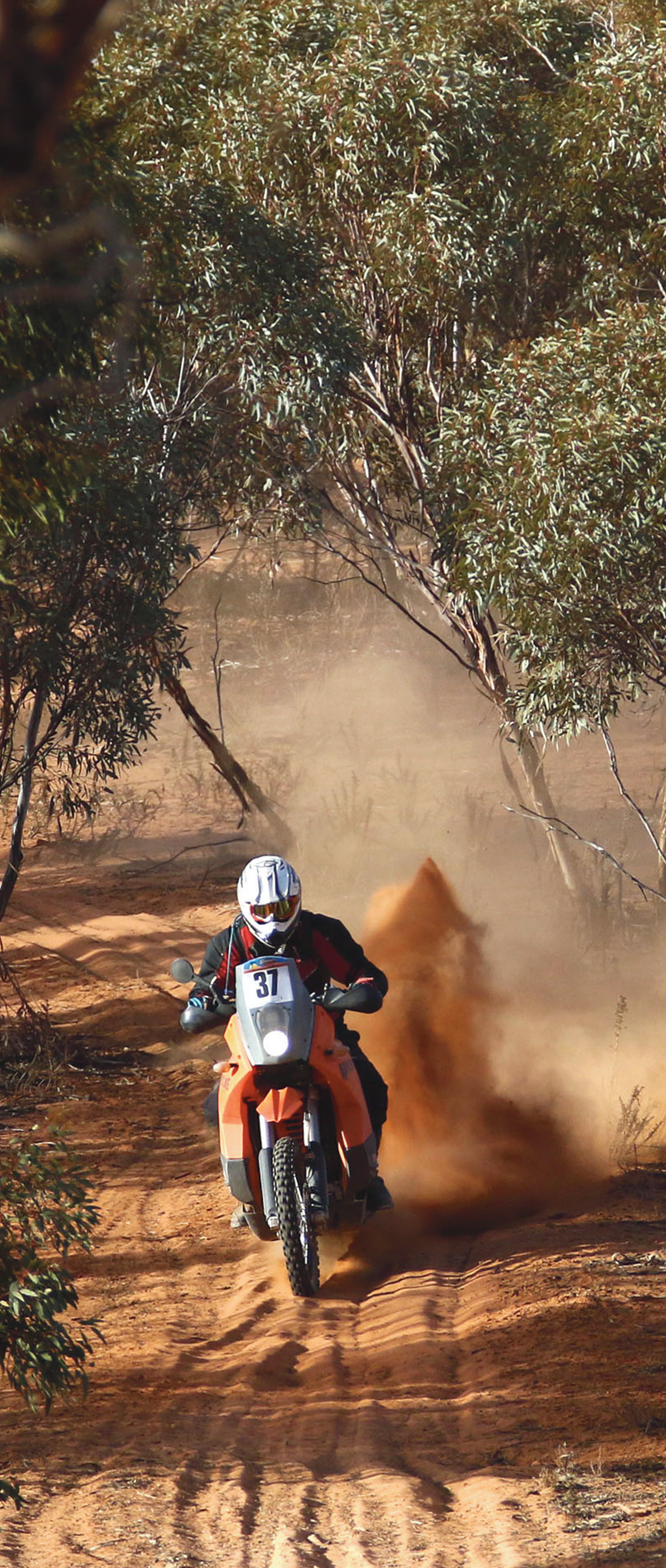
Truck off
Paul Bannister, a bike mechanic who grew up in the Riverina before moving to Queensland’s Sunshine Coast, was elated he made the decision to bolt a borrowed nav tower onto his two-year-old KTM 1190 and make the long drive south. “I’ve done a lot of riding over the past 40 years, including Finke, and I’ve always wondered how cross-country riders can go so quickly while reading a map,” pondered Bannister.
“The atmosphere at Wentworth was so laid back. We camped next to Don Lark, who went out of his way to help me interpret the route scrolls and set up the nav gear. Everyone was really helpful.”
Starting 22nd, Paul finished his first day of navigation only a few positions down.
“I was feeling quite satisfied with myself” said Paul, “and figured I could only improve.” On the second day he did, a real confidence booster, but day three turned to dust.
“I was riding around in circles and had no idea where I was in relation to the course,” recalled Paul, “but I got to a point I remembered from my early days and knew I could ride to the Gol Gol pub then take the blacktop back to the bivouac.
It was very tempting but I continued on in circles.
“Then the Racesafe told me to ‘STOP’.
So I did. Then it told me I was lost. ‘Tell me something I don’t know,’ I thought.
And it did. And directed me back on track.
I later learned Racesafe made a few of the auto competitors aware of my situation.
The last thing you want to see is a six-litre Trophy Truck headed your way.”
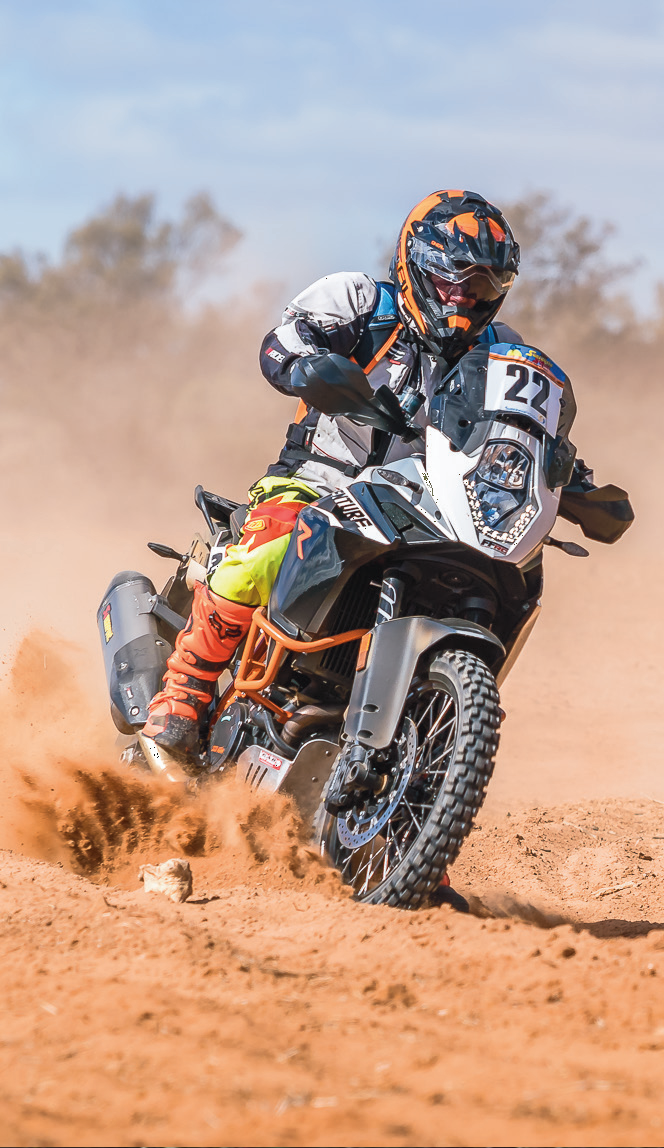 Troy Bennett’s open invitation to adventure riders was to promote the recreational aspects of cross-country rallying.
Troy Bennett’s open invitation to adventure riders was to promote the recreational aspects of cross-country rallying.
Race safe
Observing Don Geyer at work monitoring the progress of both riders and auto crews made the benefits of Racesafe so obvious in keeping competitors apart.
Maybe in the future sophisticated electronics will enable riders to avoid emus, strainer posts and radiator-piercing ironbark tree branches. This would have been of great assistance to: Joel Spoor, who broke a collarbone and a few emu bones on day two after breaking into the top 20 from his 38th starting possie;
Simon Jenner, whose Husaberg burnt to a crisp after hitting something immovable; and Ant Diener, who’d just climbed into the top 10 before puncturing the SWM’s radiator on the final day.
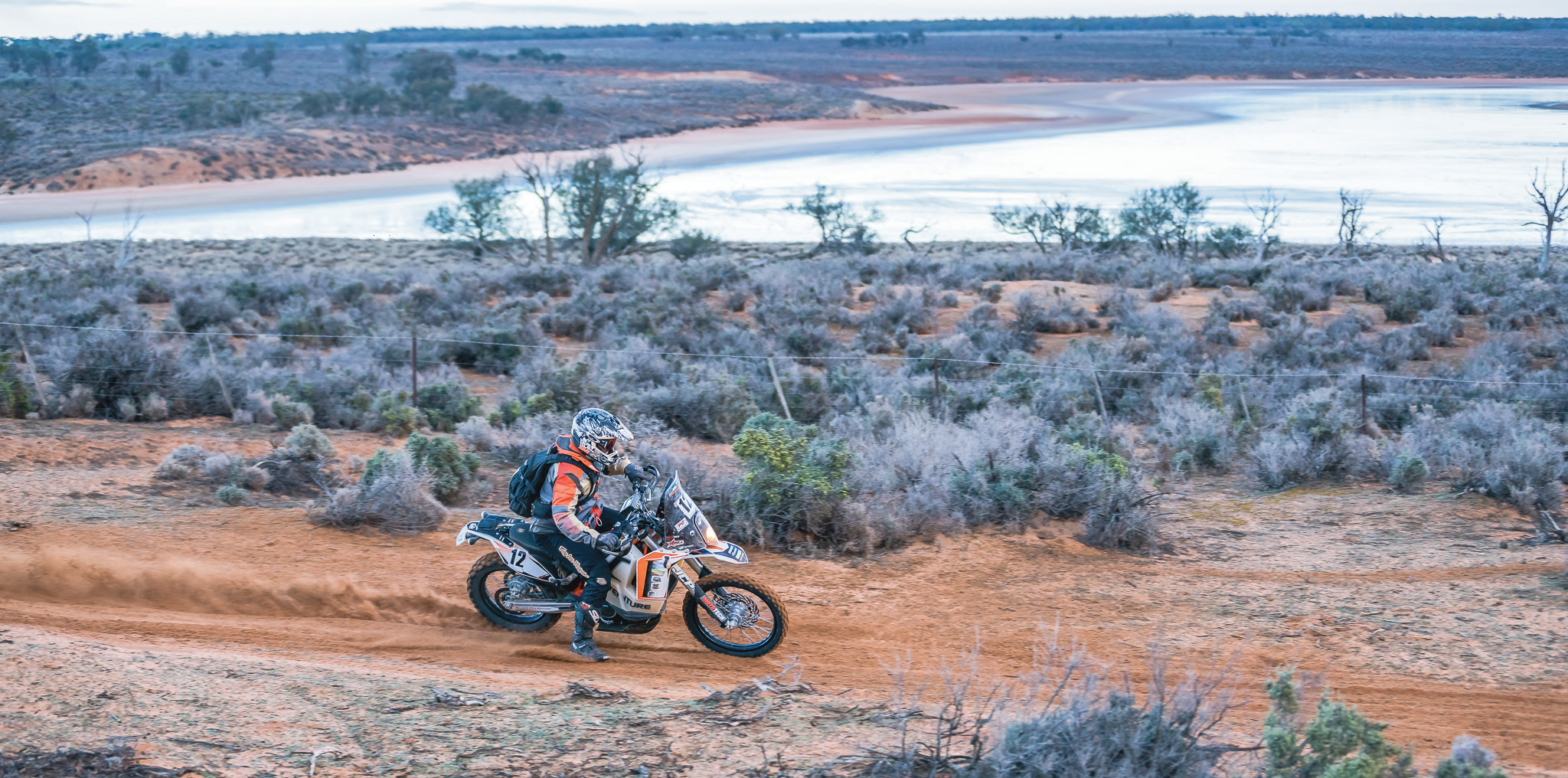 When you’re out there all alone your imagination could take you anywhere.
When you’re out there all alone your imagination could take you anywhere.
Big call
Conrad Fairhead – a bloke who has found several ways to traverse the Nullarbor – made the long journey from Western Australia to Wentworth with younger brother Dan in search of a new adventure.
“We didn’t know anybody when we arrived, but everyone was inclusive from the start. I had a problem with my ICO and asked the nearest person who looked as though they knew what they were doing. He inspected it and decided it was beyond repair and, in his next breath, gave me his spare to use. Turns out it was Don Lark.”
Don Lark, Condobolin’s Honda dealer, was in the Over 45 class, in which he’s been competing for about 45 years.
He finished in the top 20 and will be back for his third Sunraysia in 2019. “It’s a really well-run event,” said Don. “Great tracks, great route notes and a great atmosphere.”
Clearly Don typified the camaraderie in the Safari bivouac.
Conrad started 36th and found the pace faster and less technical than expected. “It was a big learning curve,” he admitted, “and it felt strange being out there alone. During the first day I felt I’d been completely forgotten by not sighting anyone, but I did okay at the end of the day. My 950 was never going to be competitive against the smaller bikes, but it felt as though it was built for this event.”

Anyone can do it
Gary Monaghan, a supporting sponsor of the Sunraysia who competed in 2017 on a KTM 500EXC and switched to a 690 Adventure, agreed the bigger bikes have one advantage: “They may be a bit of a handful on the competitive stages,” he said, “but they’re a little more relaxed on the transport stages.” Gary, who scored a top-10 outright in winning the Adventure division, reckoned the class will ensure the growth of cross-country racing in Australia.
It’s difficult not to agree. Fewer and fewer riders have the means or the motivation to build up a dedicated cross-country rally bike for a sport that receives little recognition. Conversely, it’s easy to fit a nav tower and ICO to your regular ride and participate in a timed adventure ride. It doesn’t matter who leads or who knows the course or who takes cornerman duty. There’s no pressure to perform. Plus there’s the reassurance that Racesafe has your back and there’s quick medivac should you need it. And a beer back at the bivouac if you don’t.
And when you’re out there all alone your imagination could take you anywhere.
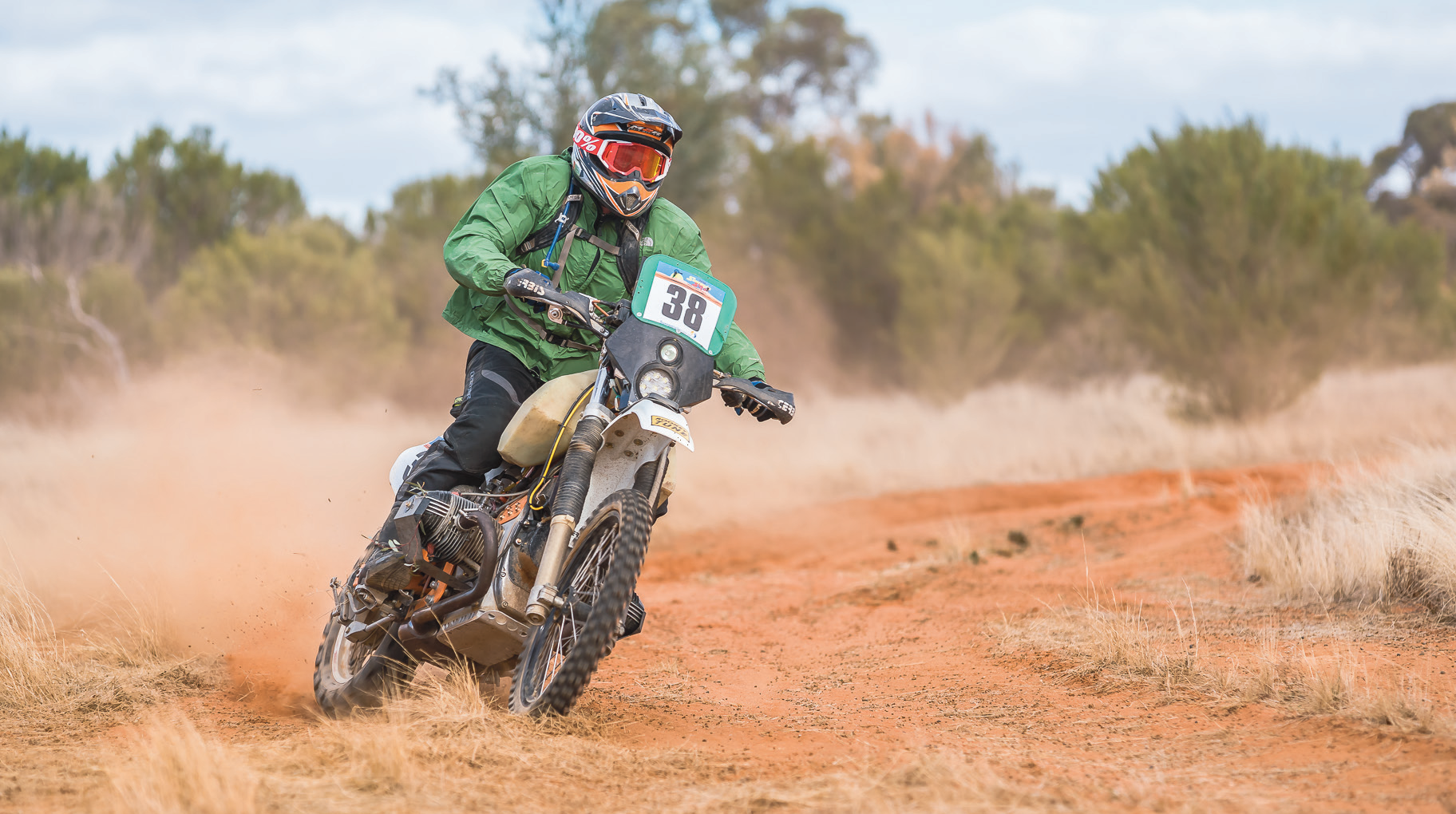 A Paul Rooney-built 1982 R65-powered special in a bespoke frame with a DRZ400 front end roosted through the H3 class on the first day.
A Paul Rooney-built 1982 R65-powered special in a bespoke frame with a DRZ400 front end roosted through the H3 class on the first day.

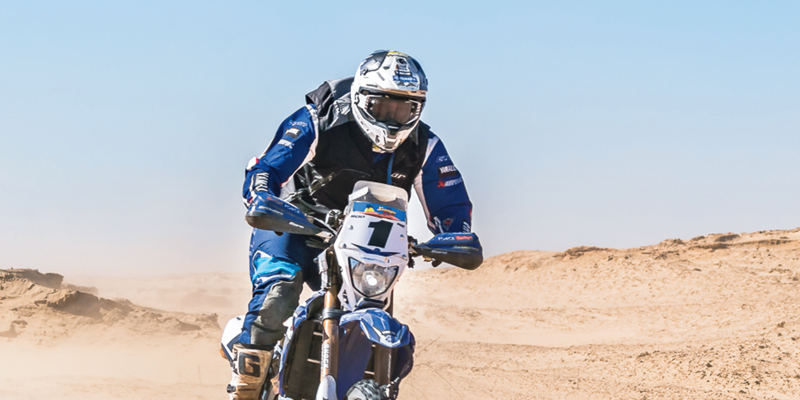





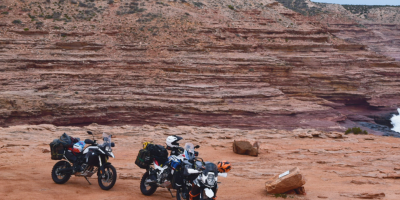






Comments